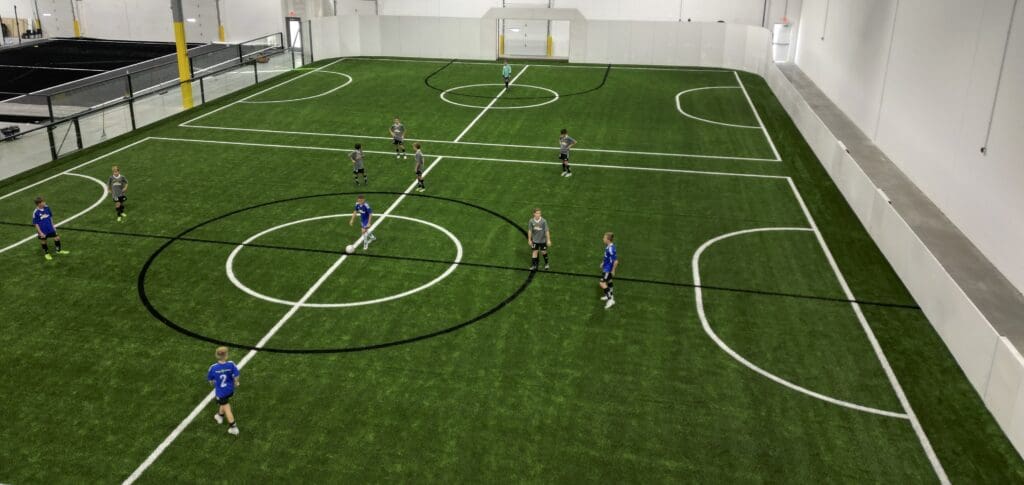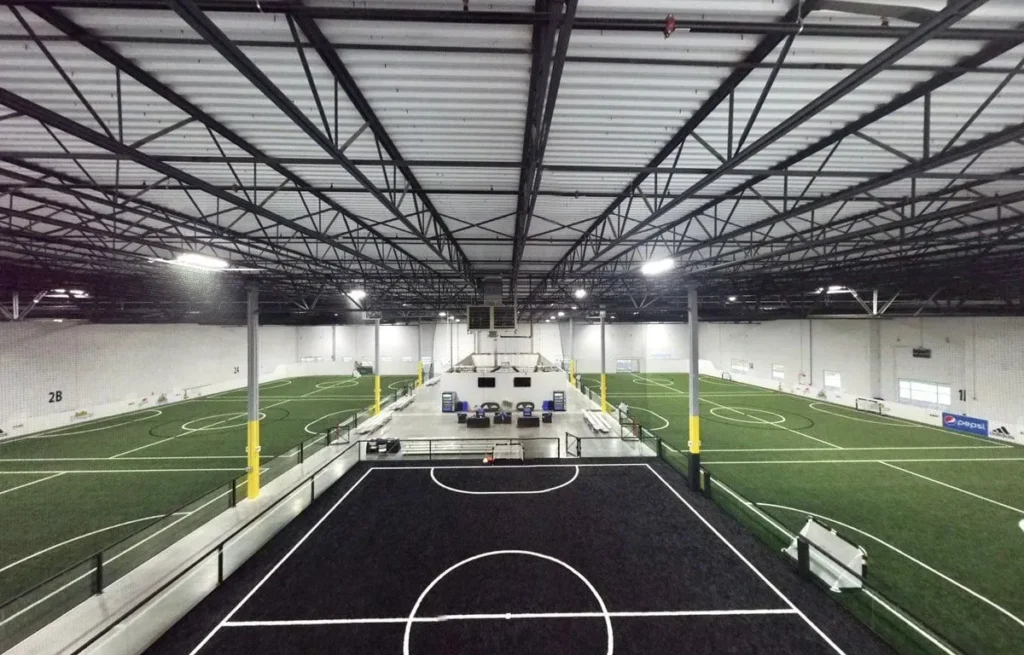Breaking Ground – Blueprint for Profitable Indoor Sports Facilities
Embark on a deep dive into the financial ingenuity of Indy Premier as they unveil their playbook for building a profitable indoor sports facility. Through strategic planning, innovative programming, and adaptive leadership, the club has set a new standard for sustainability in youth sports, offering valuable insights and inspiration for organizations striving to follow in their footsteps.
Organization and Leader
Indy Premier, Indiana / Matt Quinn
Background
Indy Premier emerged in 2014 through a merger of three soccer clubs, swiftly establishing itself as a cornerstone of youth soccer in Indianapolis. With 3,000 players, including 1,500 recreation players and 1,200 travel players, the club has flourished under the leadership of CEO Jamie Wood. With a need for year-round outdoor and indoor training facilities, the club embarked on a a journey to increase its footprint by building a new indoor sports facility and office space, and establishing a new standard for sustainability in youth sports.


Strategic Facility Design: Maximizing Space, Minimizing Costs
Indy Premier’s approach to facility design is a masterclass in efficiency. By prioritizing the club’s core needs—year-round training for its teams and office space for staff—Matt Quinn ensured that every inch of the 52,000-square-foot facility served a purpose. The deliberate decision to limit the footprint, avoiding extravagant full-sized fields, significantly reduced construction costs and ongoing operational expenses. Larger projects tend to become extremely expensive and often require public, private and governmental partnerships to make the return on investment work particularly with high costs of materials and bank interest rates. Often these projects are focused on economic development of the region and sports tourism to bring in revenue for hotels and restaurants in the area. More often than not projects of such grand scale fail to get off the ground as costs become prohibitive.
Key Tip: When designing a sports facility, prioritize functionality over grandeur. Every square foot should serve a purpose, maximizing utility while minimizing costs.
Financial Pro Forma: Securing Sustainable Revenue Streams
Central to Indy Premier’s success is a meticulously crafted financial pro forma that prioritizes the club’s financial sustainability. By strategically scheduling revenue generating programs such as leagues and clinics on the weekends, and therefore preserving weeknight prime time for travel training sessions, Indy Premier prioritized its travel program while ensuring consistent revenue streams.
The club was extremely innovative in it’s approach to funding the build. For several years the club charged members a $100 facility fee as part of registration. The improvement fund accumulated at over $100,000 per year. The club also refinanced Trinity to release equity, a 20 acre baseball complex the club purchased in 2019 and converted to a soccer facility.
Key Tip: Develop a comprehensive financial plan that aligns with your organization’s goals and priorities. Prioritize sustainable revenue streams over short-term gains.
Community Engagement: Fostering Growth Through Inclusive Programming
Indy Premier’s commitment to community engagement extends beyond its core teams, encompassing a diverse range of programs catering to players of all skill levels. The Rec Plus program, bridging the gap between recreation and travel soccer, operates year-round, providing opportunities for players to develop their skills in a supportive environment. Directed by Craig Woodfill (Rec Plus Director), over 1000 players participate in the 6 soccer seasons per year (4 indoor and 2 outdoor). By fostering inclusivity and accessibility, Indy Premier not only attracts new members but also cultivates a vibrant soccer community.
Key Tip: Foster community engagement and support for the investment, with year-round programs bridging recreation and travel soccer.
Adaptability and Resilience: Overcoming Challenges with Strategic Planning
Challenges inevitably surface and Indy Premier’s leadership demonstrated remarkable adaptability and resilience. Despite navigating increased construction costs amidst the COVID -19 pandemic, the club successfully opened its new facility immediately prior to the peak revenue-generating season, showcasing the efficacy of strategic planning and proactive risk mitigation. By anticipating potential obstacles and devising contingency plans, Indy Premier emerged stronger than ever, setting a precedent for organizational resilience.
Key Tip: Anticipate and mitigate potential challenges through proactive planning and flexibility.
To-do List for Youth Sports Executives
- Develop a comprehensive financial pro forma that prioritizes space utilization for both team training and recreational programming.
- Strategically design facilities with adaptable layouts, utilizing barriers to maximize training areas and increase efficiency.
- Elleviate financial pressures during critical training times, prioritizing team needs over external revenue generation.
- Establish measurements of success, such as player retention, member growth, financial sustainability, program expansion, and partnership attractiveness.
- Anticipate and mitigate potential challenges in facility design and construction, ensuring resilience and operational efficiency in the face of unforeseen circumstances.
Get Involved! It’s free and Open Source
Start by comparing your club’s performance to 60 best practices and access to IYSL Best Practice Analysis Tool and receive a detailed report.
Get recognized – contact David Newbery if you have an example of best practice and are willing to share your story of success with the youth sports community. [email protected]
Join IYSL LinkedIn Group and Newsletter
